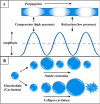Ultrasound-Responsive Nanocarriers in Cancer Treatment: A Review
- PMID: 33860189
- PMCID: PMC8033618
- DOI: 10.1021/acsptsci.0c00212
Ultrasound-Responsive Nanocarriers in Cancer Treatment: A Review
Abstract
The safe and effective delivery of anticancer agents to diseased tissues is one of the significant challenges in cancer therapy. Conventional anticancer agents are generally cytotoxins with poor pharmacokinetics and bioavailability. Nanocarriers are nanosized particles designed for the selectivity of anticancer drugs and gene transport to tumors. They are small enough to extravasate into solid tumors, where they slowly release their therapeutic load by passive leakage or biodegradation. Using smart nanocarriers, the rate of release of the entrapped therapeutic(s) can be increased, and greater exposure of the tumor cells to the therapeutics can be achieved when the nanocarriers are exposed to certain internally (enzymes, pH, and temperature) or externally (light, magnetic field, and ultrasound) applied stimuli that trigger the release of their load in a safe and controlled manner, spatially and temporally. This review gives a comprehensive overview of recent research findings on the different types of stimuli-responsive nanocarriers and their application in cancer treatment with a particular focus on ultrasound.
© 2021 American Chemical Society.
Conflict of interest statement
The authors declare no competing financial interest.
Figures









Similar articles
-
Drug Release via Ultrasound-Activated Nanocarriers for Cancer Treatment: A Review.Pharmaceutics. 2024 Oct 27;16(11):1383. doi: 10.3390/pharmaceutics16111383. Pharmaceutics. 2024. PMID: 39598507 Free PMC article. Review.
-
Stimuli-responsive polymeric nanocarriers for the controlled transport of active compounds: concepts and applications.Adv Drug Deliv Rev. 2012 Jun 15;64(9):866-84. doi: 10.1016/j.addr.2012.01.020. Epub 2012 Feb 11. Adv Drug Deliv Rev. 2012. PMID: 22349241 Review.
-
Stimuli-responsive chitosan-based nanocarriers for cancer therapy.Bioimpacts. 2017;7(4):269-277. doi: 10.15171/bi.2017.32. Epub 2017 Nov 15. Bioimpacts. 2017. PMID: 29435435 Free PMC article. Review.
-
Stimuli-responsive image-guided nanocarriers as smart drug delivery platforms.Expert Opin Drug Deliv. 2022 Nov;19(11):1487-1504. doi: 10.1080/17425247.2022.2134853. Epub 2022 Oct 18. Expert Opin Drug Deliv. 2022. PMID: 36214740 Review.
-
Ultrasound-mediated nano drug delivery for treating cancer: Fundamental physics to future directions.J Control Release. 2023 Mar;355:552-578. doi: 10.1016/j.jconrel.2023.02.009. Epub 2023 Feb 15. J Control Release. 2023. PMID: 36773959 Review.
Cited by
-
Multi-modal triggered-release sonodynamic/chemo/phototherapy synergistic nanocarriers for the treatment of colon cancer.Front Bioeng Biotechnol. 2024 Jul 22;12:1439883. doi: 10.3389/fbioe.2024.1439883. eCollection 2024. Front Bioeng Biotechnol. 2024. PMID: 39104624 Free PMC article.
-
Encapsulation, Release, and Cytotoxicity of Doxorubicin Loaded in Liposomes, Micelles, and Metal-Organic Frameworks: A Review.Pharmaceutics. 2022 Jan 21;14(2):254. doi: 10.3390/pharmaceutics14020254. Pharmaceutics. 2022. PMID: 35213987 Free PMC article. Review.
-
An Engineered Specificity of Anti-Neoplastic Agent Loaded Magnetic Nanoparticles for the Treatment of Breast Cancer.Polymers (Basel). 2021 Oct 20;13(21):3623. doi: 10.3390/polym13213623. Polymers (Basel). 2021. PMID: 34771179 Free PMC article.
-
Drug release study of the chitosan-based nanoparticles.Heliyon. 2021 Dec 24;8(1):e08674. doi: 10.1016/j.heliyon.2021.e08674. eCollection 2022 Jan. Heliyon. 2021. PMID: 35028457 Free PMC article. Review.
-
Rapid Magneto-Sonoporation of Adipose-Derived Cells.Materials (Basel). 2021 Aug 27;14(17):4877. doi: 10.3390/ma14174877. Materials (Basel). 2021. PMID: 34500968 Free PMC article.
References
-
- Cancer Research UK . Worldwide cancer statistics. https://www.cancerresearchuk.org/health-professional/cancer-statistics/w... (accessed September 8, 2020).
-
- Kaplun A. P.; Bezrukov D. A.; Shvets V. I. (2011) Rational Design of Nano- and Micro-Size Medicinal Forms of Biologically Active Substances. Appl. Biochem. Microbiol. 47 (8), 711–717. 10.1134/S0003683811080072. - DOI
Publication types
Grants and funding
LinkOut - more resources
Full Text Sources
Other Literature Sources
